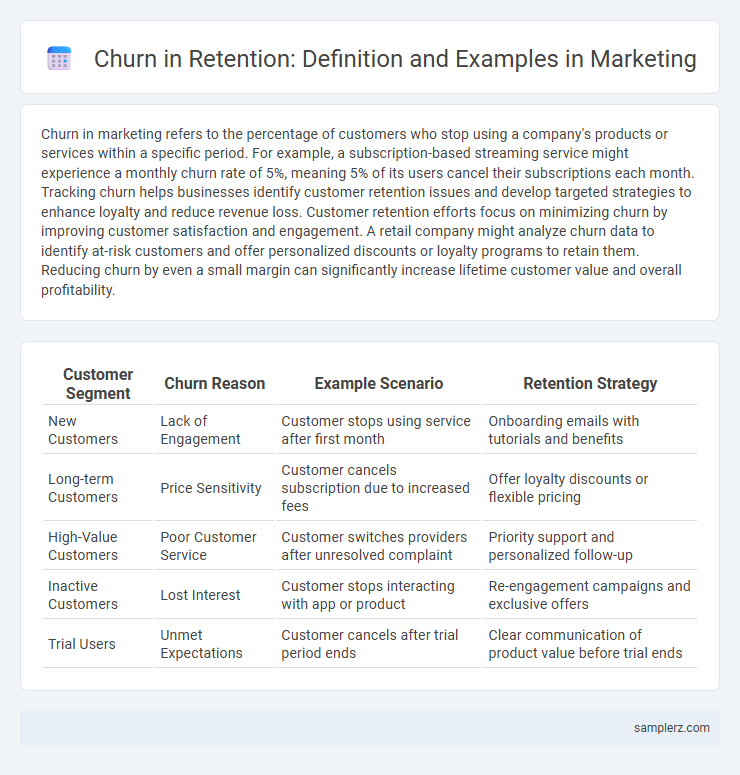Churn in marketing refers to the percentage of customers who stop using a company's products or services within a specific period. For example, a subscription-based streaming service might experience a monthly churn rate of 5%, meaning 5% of its users cancel their subscriptions each month. Tracking churn helps businesses identify customer retention issues and develop targeted strategies to enhance loyalty and reduce revenue loss. Customer retention efforts focus on minimizing churn by improving customer satisfaction and engagement. A retail company might analyze churn data to identify at-risk customers and offer personalized discounts or loyalty programs to retain them. Reducing churn by even a small margin can significantly increase lifetime customer value and overall profitability.
Table of Comparison
| Customer Segment | Churn Reason | Example Scenario | Retention Strategy |
|---|---|---|---|
| New Customers | Lack of Engagement | Customer stops using service after first month | Onboarding emails with tutorials and benefits |
| Long-term Customers | Price Sensitivity | Customer cancels subscription due to increased fees | Offer loyalty discounts or flexible pricing |
| High-Value Customers | Poor Customer Service | Customer switches providers after unresolved complaint | Priority support and personalized follow-up |
| Inactive Customers | Lost Interest | Customer stops interacting with app or product | Re-engagement campaigns and exclusive offers |
| Trial Users | Unmet Expectations | Customer cancels after trial period ends | Clear communication of product value before trial ends |
Understanding Churn: Definition and Impact on Retention
Churn refers to the percentage of customers who stop using a product or service within a specific timeframe, directly impacting retention rates. High churn rates indicate dissatisfaction, reducing revenue growth and increasing acquisition costs for marketing teams. Understanding churn causes, such as poor user experience or better competitor offerings, enables targeted strategies to improve customer loyalty and lifetime value.
Common Types of Churn in Marketing
Common types of churn in marketing include voluntary churn, where customers actively decide to stop using a product or service, and involuntary churn, caused by factors such as payment failures or account issues. Revenue churn occurs when high-value customers leave, significantly impacting the company's income. Understanding these churn types enables marketers to develop targeted retention strategies and improve customer lifetime value.
Identifying Early Signs of Customer Churn
Analyzing customer engagement metrics such as reduced login frequency, declining purchase volumes, and negative sentiment in feedback helps identify early signs of customer churn. Predictive analytics models leveraging historical behavior patterns can forecast churn probability, enabling timely intervention with personalized retention campaigns. Monitoring these signals allows marketers to proactively address customer dissatisfaction and improve long-term retention rates.
Real-World Examples of Churn in Different Industries
Subscription-based streaming services often experience churn when users cancel their memberships due to content saturation or pricing changes, as seen with Netflix's fluctuating user retention rates in 2023. In the telecommunications industry, churn is frequently triggered by service outages or competitor promotions, highlighted by Verizon's customer losses during network disruptions. Retail subscription boxes, such as Birchbox, face churn challenges linked to inconsistent product quality and delivery delays, impacting long-term customer loyalty.
Case Study: High Churn Rates in Subscription Services
High churn rates in subscription services often result from poor user engagement and unclear value propositions, as seen in a case study of a streaming platform experiencing a 25% monthly churn. The platform addressed retention by implementing personalized content recommendations and flexible subscription plans, leading to a 15% decrease in churn within six months. Effective customer feedback analysis and targeted re-engagement campaigns prove crucial in reducing churn and improving lifetime value in subscription-based models.
Analyzing Customer Exit Surveys for Churn Insights
Analyzing customer exit surveys provides critical insights into churn by identifying specific reasons behind customer departures, such as dissatisfaction with product features or poor customer service. This data-driven approach enables marketing teams to implement targeted retention strategies, improve product offerings, and personalize communication to reduce future churn rates. Leveraging exit survey analytics enhances customer lifetime value by addressing pain points that directly influence customer loyalty.
How Poor Onboarding Leads to Increased Churn
Poor onboarding processes result in customers feeling confused or unsupported, leading to dissatisfaction and higher churn rates. Data shows that businesses with ineffective onboarding experience up to 70% greater customer attrition within the first 90 days. Investing in clear tutorials, personalized guidance, and timely support significantly improves retention by reducing early customer drop-off.
Role of Customer Experience in Reducing Churn
Customer experience plays a crucial role in reducing churn by enhancing satisfaction and fostering loyalty through personalized interactions, timely support, and seamless omnichannel engagement. Brands that invest in proactive customer service and continuous feedback loops see significant declines in churn rates, as customers feel valued and understood. Data-driven insights enable marketers to anticipate pain points and tailor retention strategies, resulting in improved lifetime value and sustained growth.
Successful Retention Strategies to Combat Churn
High-value subscription services implemented personalized email campaigns targeting users showing signs of inactivity, resulting in a 15% decrease in churn rates within six months. Companies that leverage predictive analytics to identify at-risk customers can deploy tailored offers and proactive customer support to enhance retention. Implementing loyalty programs that reward consistent engagement fosters long-term customer commitment and reduces the likelihood of churn.
Measuring and Monitoring Churn for Ongoing Retention
Measuring and monitoring churn involves tracking the percentage of customers who cancel or stop using a service within a given time frame, crucial for identifying retention challenges. Key metrics include the monthly churn rate, customer lifetime value (CLV), and churn reason analysis derived from surveys or behavioral data. Regular analysis of these metrics enables targeted interventions, optimizing customer retention strategies and improving long-term business growth.

example of churn in retention Infographic
 samplerz.com
samplerz.com